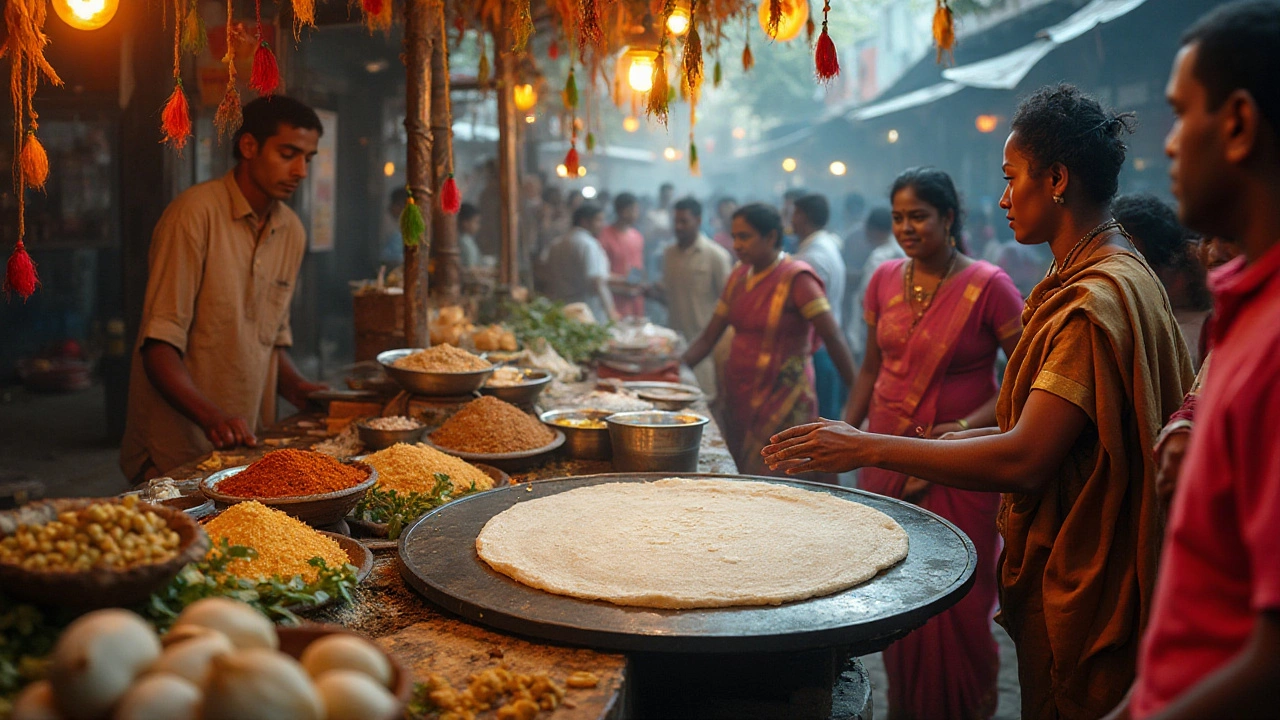SEARCH
Dosa – Your Quick Guide to South India’s Favorite Pancake
If you’ve ever watched a sizzling skillet and seen a thin, golden circle appear, that’s a dosa. It’s basically a fermented rice‑and‑lentil crepe that’s crispy on the edges and soft inside. The magic starts with the batter – soak equal parts rice and urad dal (black gram), grind them smooth, add a pinch of salt, and let it ferment overnight. The longer the fermentation, the more airy the dosa becomes.
How to Make a Classic Dosa at Home
All you need is a non‑stick pan, a ladle, and a steady hand. Heat the pan, drizzle a few drops of oil, and pour a thin layer of batter in a circular motion. Let it cook for 2‑3 minutes until the edges lift, then flip if you like a double‑crisp, or keep it unflipped for the traditional style. Serve it hot with coconut chutney, sambar, or a simple tomato‑onion pickle. The whole process takes under 15 minutes once the batter is ready, and the taste is worth every minute.
Where to Find the Best Dosas in India
Traveling through South India? Here are three must‑visit spots that serve dosas that’ll blow your mind:
- Udupi, Karnataka – The birthplace of many styles. Try the “paper dosa” at any local eatery; it’s super thin and crunchy.
- Chennai, Tamil Nadu – Head to the famous Saravana Bhavan for a classic masala dosa stuffed with spiced potatoes.
- Trivandrum, Kerala – Look for “ghee roast” dosas drenched in butter; they’re rich, aromatic, and perfect with Kerala’s spicy sambhar.
These places are budget‑friendly too. A plain dosa costs under ₹30, while a masala version is around ₹60‑80. If you’re on a shoestring, aim for the breakfast counters where locals line up – you’ll get authentic flavor without the tourist markup.
When you plan a dosa‑tour, keep a few practical tips in mind. First, the best time to visit the south is between October and March; the weather is cool enough for street food walks. Second, bring a reusable water bottle – many stalls offer fresh coconut water, which pairs perfectly with a hot dosa. Third, don’t be shy about asking locals for “the hidden gem” stalls; they’ll point you to places that don’t appear on big‑city guidebooks.
Health‑wise, dosas are a great option. The fermentation process breaks down the carbs, making them easier to digest. Pair them with protein‑rich sambar and a side of veggies, and you’ve got a balanced meal. If you’re watching calories, go easy on the ghee and stick to simple fillings like onions or tomato.
Beyond breakfast, dosa culture spills into festivals and regional celebrations. During Pongal in Tamil Nadu, families prepare huge batches of dosas to share with neighbors. In Kerala’s Onam feast, a special “neer dosa” – a soft, watery version – makes its appearance. Experiencing these events gives you a taste of how deeply dosa is woven into daily life.
Finally, if you love cooking, bring a small jar of the batter back home. It stays fresh for a few days in the fridge, and you can whip up a quick snack any time you’re craving that familiar crunch. A little practice and you’ll master the art of flipping a perfect dosa without any fancy equipment.
So whether you’re planning a trip, looking for a new breakfast idea, or just curious about South Indian food, keep dosa at the top of your list. It’s cheap, tasty, and a window into India’s rich culinary heritage.

Exploring the Flavors of South India's Famous Dish: Dosa
Dosa, a celebrated staple of South Indian cuisine, has charmed taste buds across the globe with its crispy texture and savory filling. Originating from the southern part of India, this versatile dish can be enjoyed in various forms and flavors, making it a must-try for travelers exploring the region. Often served with coconut chutney and sambar, Dosa offers a delectable experience of the rich culinary heritage of South India. This article dives into the history, variations, and tips for savoring this beloved delicacy during your travel adventures. Discover the secrets behind the art of making Dosa and where to find the best ones throughout South India.
Continue reading